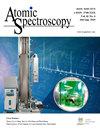南滩和阿勒泰铁陨石含碳矿物原位模拟碳同位素分析及其成因意义
IF 2.3
2区 化学
Q1 SPECTROSCOPY
引用次数: 1
摘要
更好地了解不同含碳矿物之间碳同位素的分馏特性将有助于了解行星的核心形成过程。在本研究中,我们对南滩和阿勒泰铁陨石进行了岩石学和原位二次离子质谱(SIMS)碳同位素分析综合研究。阿勒泰IIIE-a铁陨石中褐长石的δ 13c值为- 14.80±2.31‰,与Colonia Obrera IIIE铁陨石中褐长石的δ 13c值不同。这表明阿勒泰的母体具有不同的初始碳同位素组成或经历了不同的行星过程(如CO 2 /CH 4的脱气)。对南滩IAB铁陨石中一个具有核-幔-环结构特征的富石墨结核进行了系统研究。结核地幔(GNM)中的石墨颗粒;δ 13c值低至- 14.65‰),结核边缘的石墨颗粒均为石墨(GNR;δ 13c = - 12.65±2.90‰)在13c中比在结核岩心(GNC;δ 13c =−7.17±2.42‰)。这可能是由于13c优先掺入早结晶的GNC。共生GNR (Δ 13 C = - 12.65±2.90‰)与纯铜矿(Δ 13 C = - 19.60±2.59‰)的碳同位素分馏(Δ 13 C = 6.9±2.7‰)得到的平衡温度为~950 ~ 1310℃,支持结核的熔融结晶成因。我们同意先前的研究,即地球早期分化可能导致地幔中石墨/金刚石和金属熔体下沉到地核之间的正碳同位素分馏。本文章由计算机程序翻译,如有差异,请以英文原文为准。
In Situ SIMS Carbon Isotopic Analysis Of Carbon-Bearing Minerals In Nantan And Aletai Iron Meteorites: Implications On Genesis
: A better understanding of the fractionation properties of carbon isotope between different carbon-bearing minerals will provide insights into the core-forming process of planets. In this study, we carried out an integrated study of petrography and in situ secondary ion mass spectroscopy (SIMS) carbon isotopic analysis for Nantan and Aletai iron meteorites. Haxonite in Aletai IIIE-an iron meteorite has a δ 13 C value of −14.80 ± 2.31‰, which is different from that of haxonite in Colonia Obrera IIIE iron meteorite. This suggests that the parent body of Aletai has a different initial carbon isotopic composition or experienced different planetary processes ( e.g. , degassing of CO 2 /CH 4 ). A graphite-rich nodule in Nantan IAB iron meteorite, characterized by a core-mantle-rim texture, was systematically studied. Some graphite grains in the nodule mantle (GNM; δ 13 C value as low as −14.65‰) and all graphite grains in the nodule rim (GNR; δ 13 C = −12.65 ± 2.90‰) are more depleted in 13 C than those in the nodule core (GNC; δ 13 C = −7.17 ± 2.42‰). This could be due to the preferential incorporation of 13 C into the early-crystallized GNC. The carbon isotopic fractionation (Δ 13 C = 6.9 ± 2.7 ‰) between coexisting GNR (δ 13 C = −12.65 ± 2.90‰) and cohenite (δ 13 C = −19.60 ± 2.59‰) yielded an equilibrium temperature of ~950–1310 °C, supporting the melt-crystallization genesis for nodule. We concur with previous studies that the early differentiation of Earth could have led to positive carbon isotopic fractionation between graphite/diamond in the mantle and metallic melt sinking to the core.
求助全文
通过发布文献求助,成功后即可免费获取论文全文。
去求助
来源期刊

Atomic Spectroscopy
物理-光谱学
CiteScore
5.30
自引率
14.70%
发文量
42
审稿时长
4.5 months
期刊介绍:
The ATOMIC SPECTROSCOPY is a peer-reviewed international journal started in 1962 by Dr. Walter Slavin and now is published by Atomic Spectroscopy Press Limited (ASPL). It is intended for the rapid publication of both original articles and review articles in the fields of AAS, AFS, ICP-OES, ICP-MS, GD-MS, TIMS, SIMS, AMS, LIBS, XRF and related techniques. Manuscripts dealing with (i) instrumentation & fundamentals, (ii) methodology development & applications, and (iii) standard reference materials (SRMs) development can be submitted for publication.
 求助内容:
求助内容: 应助结果提醒方式:
应助结果提醒方式:


